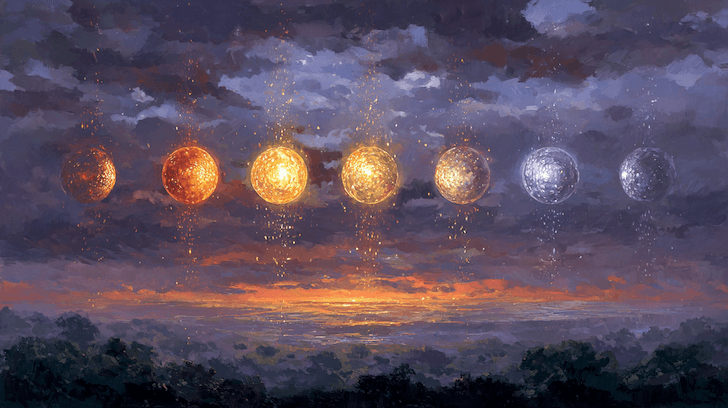Planet Meanings in Astrology

Planets are the active forces in astrology. They represent drives, needs, and functions of consciousness—how you act, feel, and respond to life. Each planet symbolizes a core human process, which is then shaped by sign (its style), house (its arena of life), and aspect (how it interacts with other planets).
Planets show the what. Signs describe how that energy behaves. Houses tell where it plays out. Aspects show who it talks to.
The Planets at a Glance
| Planet | Keywords | Themes |
|---|---|---|
| Sun | Vitality, purpose, will | Core identity and expression |
| Moon | Emotion, needs, instinct | Mood, comfort, memory, and care |
| Mercury | Mind, speech, logic | Thoughts, communication, learning |
| Venus | Harmony, attraction, pleasure | Love, aesthetics, values, money |
| Mars | Drive, courage, conflict | Action, energy, assertion, desire |
| Jupiter | Growth, luck, faith | Expansion, wisdom, opportunity, belief |
| Saturn | Discipline, limits, structure | Responsibility, maturity, mastery |
| Uranus | Change, innovation, rebellion | Freedom, technology, awakening |
| Neptune | Dream, idealism, transcendence | Spirituality, art, illusion, compassion |
| Pluto | Power, death, rebirth | Transformation, intensity, regeneration |
The Luminaries
The Sun symbolizes vitality, purpose, and the conscious self. It’s your steady light—what keeps you alive, motivated, and visible. Where the Sun falls by sign and house shows where you need to shine and what fuels your confidence. Transits to the Sun often bring focus, clarity, or ego challenges.
The Moon governs emotion, instinct, and habit. It shows your natural comfort zone and how you process feelings. The Moon’s sign and house describe what makes you feel safe and nurtured. Transits to the Moon bring mood shifts and emotional weather; they’re often the most noticeable in daily life.
The Inner Planets
Mercury represents thought, speech, and information exchange. It describes how you learn, articulate ideas, and handle data. In air and fire signs it’s analytical and expressive; in earth and water signs it’s reflective and practical. Mercury retrograde periods ask you to slow down, review, and reconnect rather than charge ahead.
Venus shows attraction, affection, and what feels harmonious. It rules how you give and receive love, your sense of beauty, and your taste for comfort or art. In charts, Venus connects relationships and values; in transits, it marks times of pleasure, diplomacy, or reassessment (especially during retrogrades).
Mars governs energy, courage, and the will to act. It fuels your ambition and shows how you handle conflict or pursuit. In the natal chart, Mars reveals your style of motivation; in transit, it triggers movement and confrontation. When retrograde, Mars turns energy inward—motivation may slow while strategy deepens.
The Social Planets
Jupiter expands whatever it touches. It rules optimism, philosophy, and the belief that growth is possible. In your chart, Jupiter points to where you seek meaning, opportunity, or abundance. By transit, it brings openings and perspective—though excess can follow if unchecked.
Saturn defines boundaries, time, and discipline. It teaches through effort and tests. In the natal chart, Saturn shows where you build endurance and skill; in transit, it brings responsibility and long-term rewards. Saturn’s lessons mature over decades—slow but permanent progress.
The Outer Planets
Uranus breaks patterns and demands freedom. It rules rebellion, innovation, and awakening. In personal charts, it marks where you’re wired differently and crave authenticity. Transits from Uranus disrupt stagnation—expect surprises, inventions, and liberation from what’s outdated.
Neptune blurs boundaries and invites imagination. It rules dreams, mysticism, and art. In a chart, Neptune shows where you idealize or dissolve limits; it can inspire profound empathy or confusion. Transits often coincide with intuition, fantasy, or disillusionment—be wary of rose-colored views.
Pluto represents transformation through power and surrender. It exposes what’s hidden and forces evolution. By sign, Pluto speaks to generational themes; by house, it shows where you face depth, control, and renewal. Transits can coincide with endings, rebirth, and reclaiming strength.
Reading Planets by Sign, House, and Aspect
- A planet’s sign modifies its expression—Mars in Leo fights proudly; Mars in Virgo strategizes quietly.
- Its house shows where the energy manifests—Venus in the 7th brings harmony to relationships, in the 10th to public work.
- Its aspects describe how it interacts with others—Jupiter trine Mercury expands ideas; Saturn square Moon tests resilience.
- When retrograde, the planet internalizes its process, emphasizing reflection over projection.
Planetary Retrogrades
Retrograde motion happens when a planet appears to move backward from Earth’s perspective. This optical illusion shifts the planet’s function inward—reviewing, revising, or reworking its themes.
| Planet | Retrograde Frequency | Typical Duration |
|---|---|---|
| Mercury | 3–4 times per year | 3 weeks |
| Venus | Every 18 months | 6 weeks |
| Mars | Every 2 years | 2–2.5 months |
| Jupiter | Yearly | 4 months |
| Saturn | Yearly | 4.5 months |
| Uranus–Neptune–Pluto | Yearly | 5 months+ |
Retrogrades don’t break function—they refine it. They’re valuable checkpoints for understanding how you use a planet’s energy and where patience pays off.
Bringing It All Together
Planets act as the verbs of astrology—always in motion, always interacting. When you know what each planet does, reading charts becomes a process of listening: Who’s speaking? How do they sound? Where are they talking? The more fluently you understand planetary language, the more clearly your chart’s story reveals itself.
Elements in Your Birth Chart

What Are Aspects in Astrology?

Get Your Birth Chart
Calculate your complete astrological chart with precise astronomical data based on your birth time and location
Generate Chart